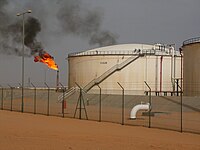The mining industry of Libya does not contribute significantly to its economy. Mining resources are located in remote regions with limited accessibility. The fuel sector, including oil reserves (which have a capacity of 29.5 billion barrels) and natural gas (which has 1.31 trillion cubic meters of reserve) is the major revenue-generating industry.[1][2]




Africa's largest proven oil reserves are in Libya.[citation needed] The first well was drilled in 1956 and oil was struck in the following year.[citation needed] The Wadi ash-Shati' may hold one of the world's biggest iron ore deposits.[citation needed]
Production and impact
editThe identified sources of minerals relate to diamondiferous kimberlites in the East Saharan craton and metamorphic belts with potential for gold in the southern region of the country. Large gypsum deposits have produced 150,000 tons per year for the manufacture of cement. Other sources include sulfur extraction (about 13,000 tons/year) as a byproduct of refining petroleum and natural gas. Iron ore from Wadi ash-Shati', approximately 900 kilometres (560 mi) from the sea,[citation needed] is also of note, with a reserve identified of 795 million tons of 52% grade. This has not been extracted due to the remoteness of its location.[1]
Substantial reserves of magnesium and potassium salts have been recorded, but apart from magnetite, phosphate rock, and sulfur, these are yet to be mined.[3] There are large salt flats in the north; production in the 1980s amounted to 11,000 tons of salt per annum.[citation needed] Oil fields include the Bouri Field, the Mediterranean's largest producing oilfield;[4] El Sharara, Elephant, Raguba, Sarir, Waha, and Zelten.
Legal framework
editThe enabling laws for mining and oil sector are in place. These are: Law 5 on Encouragement of Foreign Capital Investment Law of 1426 (1997) and Law 25 of the Petroleum Law of 1955.[2]
Commodities
editPetroleum products are the major industry in Libya,[3] with mineral extraction being limited, and not making up a significant portion of the country's economy. The mining of raw materials is limited mainly to industrial minerals such as clay, cement, salt and limestone.[2] Libya's output in 2000 included 270,000 tons of lime and 175,000 tons of gypsum. Other mineral reserves consist of potash in the Sirte Desert, magnetite, phosphate rock, and sulfur.[3]
See also
editReferences
edit- ^ a b "Mining in Libya- Overview". mbendi.com. Archived from the original on 28 January 2001. Retrieved 30 May 2015.
- ^ a b c Mobbs, Philip M. "The Mineral Industry Of Libya" (PDF). USGS. Retrieved 30 May 2015.
- ^ a b c "Libya – Mining". nationsencyclopedia.om.
- ^ Middle East Reservoir Review Archived 2010-02-15 at the Wayback Machine